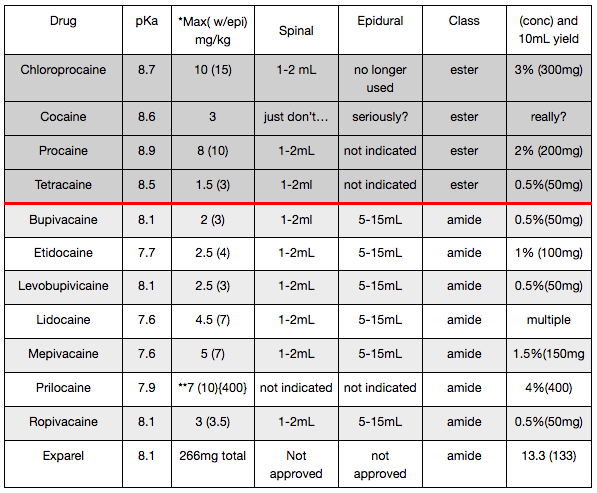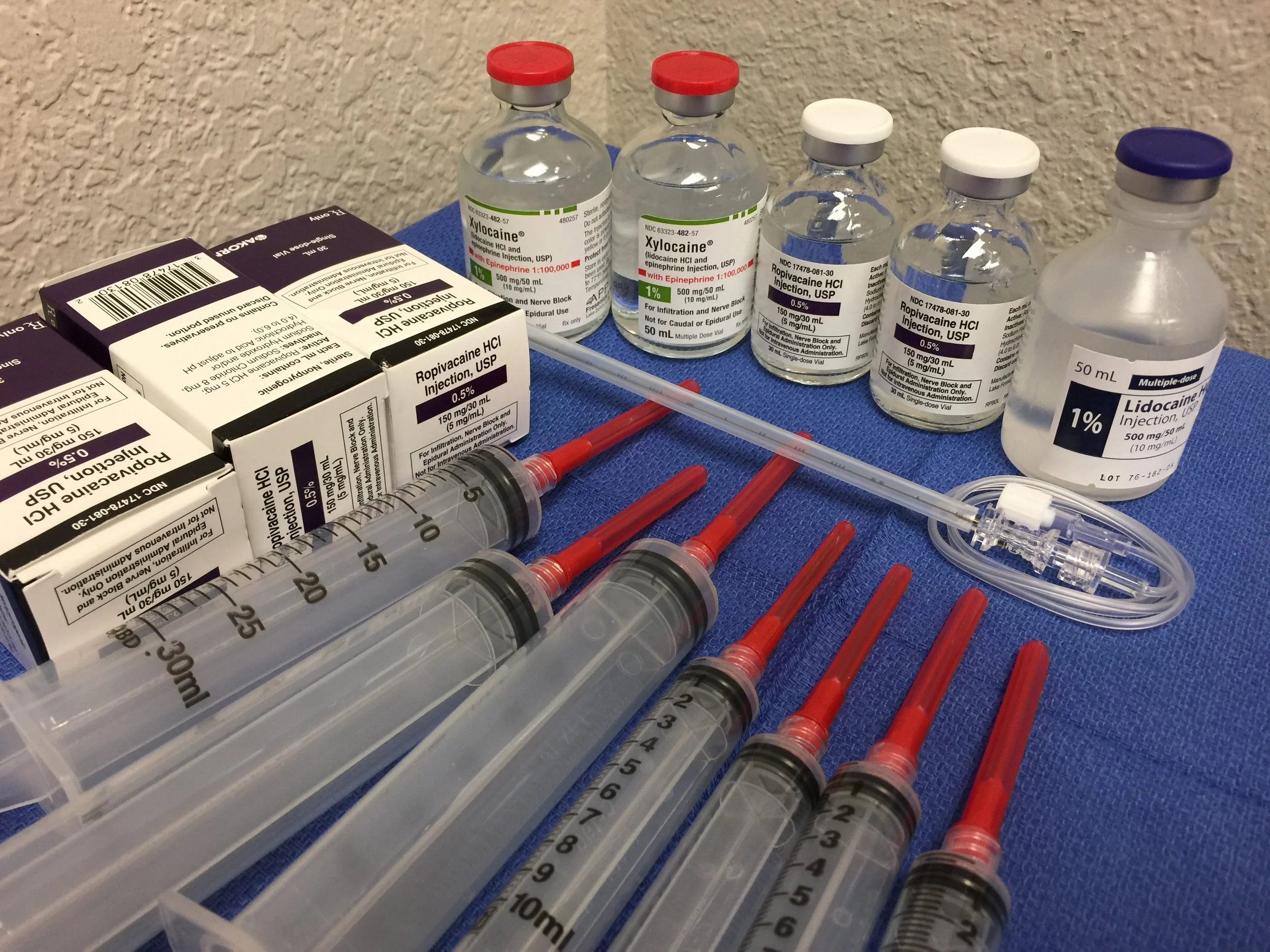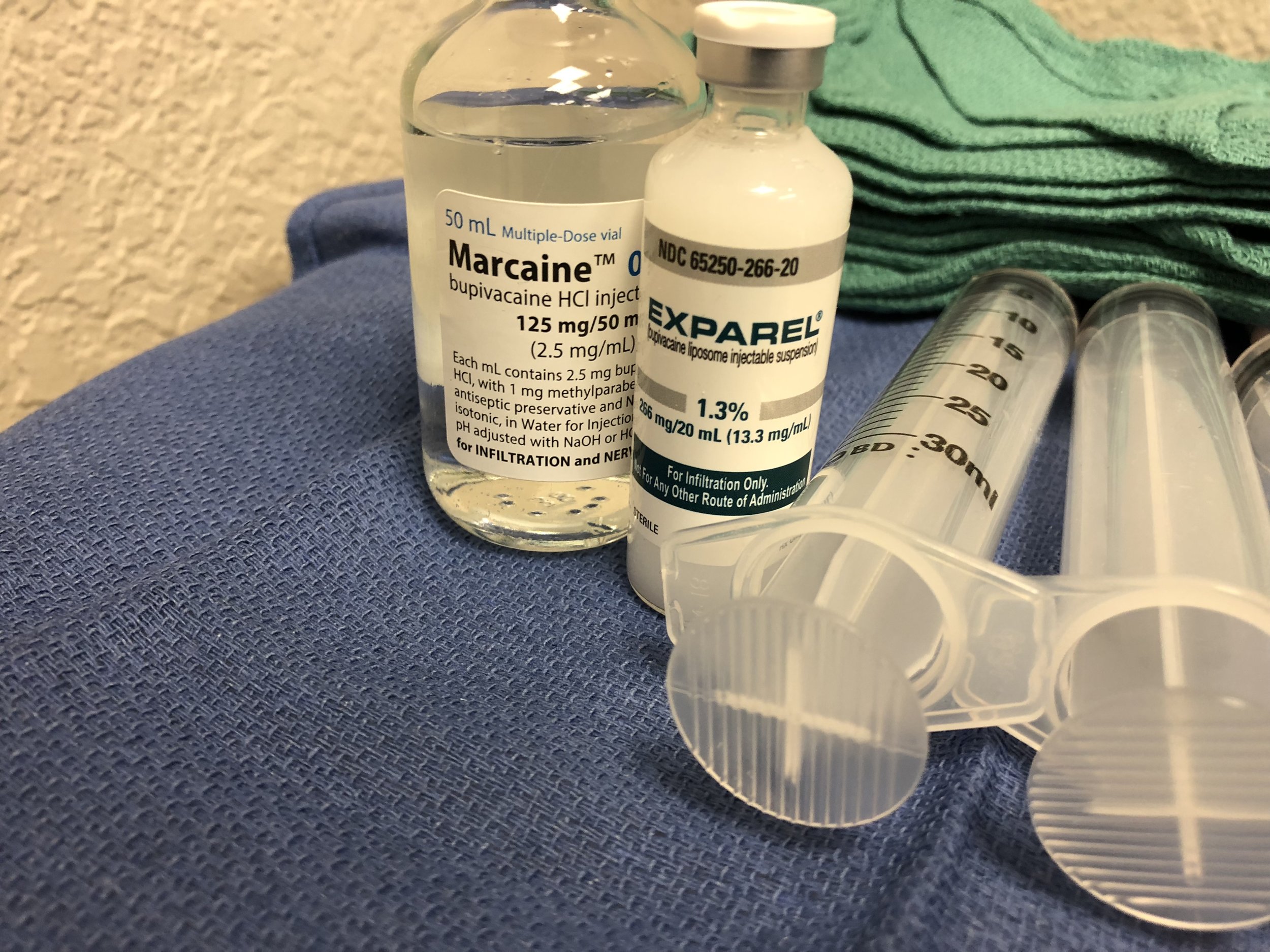*Certain assumptions have been made regarding the assignment of maximum dose regimens. These have been made reviewing multiple sources, that all have different conclusions to this very issue. It’s important to remember that these numbers, while listed as discrete values, certainly are not. They should be variable based on the multitude of patient presentations and goals of the regional technique, such as desired speed of onset, need for motor blockade, desired length of blockade, co-existing disease, protein status, and many other variables that make these dose suggestions increases or decrease, depending on the specific patient profile. These numbers are merely suggestions as a convenience to you- the reader. The actual dose assignment is up to the individual provider. Twin Oaks Anesthesia assumes no liability for poor outcomes related to local anesthetic selection or dose by any provider.
Additionally, the doses of the epidural ranges listed here make the assumption of a lumber epidural requiring an INITIAL dose of local anesthetic. Many factors go into the decision for local anesthetic for epidural dosing, it would be foolish to use this chart as your sole decision reference for epidural dosing.
** Max dose of Prilocaine has been set at about 400mg for adults for the reason of methemoglobinemia. See section in local anesthetics chapter for details on recognition and treatment.
One of the cornerstones of regional anesthesia is understanding the basics of local anesthetics. Each local anesthetic is unique and has characteristics that can optimize a particular block. Understanding the basic theory of the mechanism of action is essential to providing regional anesthesia. The building blocks of how locals work resides in understanding the sodium channel blockade. Nerve conduction is dependent on the cell membranes ability to change its permeability to primarily sodium, and to some extent potassium. This is made possible via the voltage-gated sodium channel. This channel connects the outside and inside of the cell, allowing the exchange of sodium ions. Although the true mechanism of action remains a mystery, this voltage-gated sodium channel is thought to be the primary site of action for local anesthetics.
There are three primary elements to understand when considering the how locals work, hydrophobicity, protein binding, and pKa. Hydrophobicity really means lipid-loving substances. This concept begins by understanding that local anesthetics are weak bases but are generally joined with a hydrochloride salt to make them slightly acidic. As such, they are primarily water soluble. However, only lipid-soluble (hydrophobic) substances can pass through the cell membrane. They are allowed into the cell via diffusion in the non-ionized form. This is the portion of the local that is lipid soluble. It should be noted that the portion of non-ionized form of local anesthetic is small considering any given volume of commercially available local solution. Once the local has passed through the cell membrane it locks the sodium channel in the “off” position preventing any further flux of sodium ions. With the sodium channel locked, conduction at that point is inhibited. Only after gaining access to the nerves cytoplasm can the local anesthetic find a hydrogen ion and become ionized. This ionized form of the local causes the sodium channel to be locked, preventing further sodium ion flux across the cell membrane. It should be noted however, that distal points to the region of blockade can still elicit a motor response such as those produced by a nerve stimulator. In this setting, a sensory response will not be transmitted to the brain, so further distal blockade (in the presence of a proximal block) should be only done with great caution as the patient may not be able to discern the pain of an intraneural injection.
Protein Binding
Protein binding is another important element of any review of local anesthetics. Like many drugs, local anesthetics are largely bound to proteins as they become absorbed. The two proteins most commonly associated with binding locals are AAG (Alpha-acid Glycoprotein) and albumin. Locals prefer to bind to AAG, and therefore saturate this binding site first. This is known as high-affinity and low-capacity binding. Any additional binding after AAG saturation is primarily done via albumin. Albumin’s ability to bind locals is quite large, but is highly influenced by the concentration of the drug and the pH of the plasma. There is a direct correlation between albumin’s binding capacity and pH. This can be explained as decreases in pH cause decreases in protein binding. This also means that acidosis causes an increase in free local anesthetic.
pKa
The next facet is a discussion of pKa. pKa is a calculated form of Ka, which is a shortened way of saying “the dissociation constant, ionization constant or acid constant”. This definition describes the tendency of ions or compounds to dissociate. pKa is really the measure of the ionized vs. non-ionized portion of the drug in a given volume. So a precise definition for pKa is the pH at which the solution is ionically balanced. And an ionically balanced solution is when 50% of the solution is ionized and the other 50% is non-ionized. This concept is important because it affects the onset time for any local anesthetic solution. The onset time relates to the speed at which the non-ionized form of the local penetrates the nerve’s cell membrane. Understanding pKa has another application as well. When a local solution has a pKa of 8, this means that at a pH of 8, the solution will be balanced. (Most commercially available local anesthetics have a pKa around 7-9). This concept is important when applied to onset time and block quality. Remember that the non-ionized local is the portion that penetrates the nerve, the remaining volume just balances the solution. The portion of the local that causes the blockade is relatively small, so if you want to raise it to at least 50% you’ll need to create a solution pH around 8 for the local in question. This way you’ll know that about 50% of your local solution has the non-ionized fraction in it and will cause the desired block. This relationship between pKa and pH is explained by the Henderson/Hasselbalch equation. This equation mathematically explains why the percentage of non-ionized fraction of local solution is generally low. This is why some providers add sodium bicarbonate to the solution. This raises the concentration of non-ionized (working) fraction, and leaves the balancing portion (non-working) portion low. This also explains why injecting local into tissue that has a very low pH (infection) may not allow a block to work. Tissue acidosis increases the fraction of non-working local, causing the working fraction to be so low, the block may not work. This factor combined with the general blind nature of stimulator guided or field infiltrations is a set up for block failure.
Local Anesthetic Toxicity
Local anesthetic toxicity is as important to be aware of as how to properly perform the techniques discussed in these chapters There appears to be a balanced system when boluses of local anesthetic are administered. Absorption occurs into the tissues and nerves serving to lessen the raise of serum concentrations. While entering the bloodstream, locals are further bound to AAG, and albumin, and some free drug is readily metabolized via first pass effect via the liver or plasma esterases. Toxicity occurs when serum concentrations of local anesthetics raise too quickly. This can be the result of a rapid uptake, or an intravascular injection. Local anesthetics can produce catastrophic effects when this occurs particularly to the nervous and cardiovascular systems. At low doses disorientation, metallic taste and tingling of the mouth and tongue occur. Higher doses produce tinnitus and muscle spasms. Truly toxic doses produce seizures and coma, followed by respiratory failure, cardiac arrest and death. Traditional resuscitation measures often prove futile as the bond between some locals and cardiac myocytes is tenacious. Certain patients and conditions place individuals at risk for local anesthesia toxicity. Patients presenting with decreased protein status, leading to a decrease in albumin levels will certainly qualify. And certain regional techniques that promote uptake from every surface that the local touches should also, theoretically, be at greater risk, based on increased uptake. This leads into the relatively new concept that different location, based on vascularity, will yield different uptakes in local than others. For contrast, the saphenous nerve block, in the adductor canal, has three sides, all of which will pull local anesthetic into the vascular space simultaneously. In constrast, the IPACK block, has an entire surface of bone, in the structures of interest. In this sense, this entire region will not encourage local anesthetic uptake, and should therefore, be less of a risk to certain patients. Weinberg et al, theorized that one of the mechanisms for cardiac failure, due to local anesthetic toxicity, is an interruption of fatty acid metabolism within the cell, and proposed that an injection of 1-1.5 cc/kg of Interlipid would counteract this problem. While not fully understood, his ideas have been reproduced in many case studies. The contribution of lipid emulsion for the treatment of severe local anesthetic toxicity has been profound, and life saving.
Reactions to Local Anesthetics
Reactions to local anesthetics is the last topic to be discussed regarding the basics of locals. This is a topic that probably represents the greatest contraindication to the practice of regional anesthesia. Despite its tremendous impact on outcome, little is available in terms of solid articles. In fact, many of the quality articles on reactions from locals are produced by our dermatology, dentistry and surgical colleagues. Very little has been produced by anesthesia professionals regarding this topic despite our predominance in administration of these drugs. Many of the articles are either of small sample populations or retrospective studies. This is probably due to safety and ethical concerns. An additional reason we tend not to give this aspect much consideration, is the fact that reactions to local anesthetics are rare and that not much is known about them. Rare events that occur in any field are poorly understood and are reported in case study fashion primarily. This aspect in, and of itself, should give us pause as anesthesia providers and renew our respect for the volumes of local anesthetic we routinely administer.
There are several types and severities of reactions from local anesthetics. These include, skin symptoms, anaphylaxis, allergic hypersensitivity, non-allergic hypersensitivity and methemoglobinemia. Its important to acknowledge the differences regarding these terms. Symptoms that are reproducible, brought on by the exposure to something, should be termed “hypersensitivity”. This term describes the reactions elicited from doses tolerated by healthy patients. The term “allergy” only applies to hypersensitivity reactions triggered by specific immune-mediated mechanisms. Non-allergic hypersensitivity develops due to non-immune causes. The most severe manifestation of hypersensitivity is termed anaphylaxis. An anaphylactic event is characterized by a generalized or systemic reaction that is severe and life-threatening. It is divided into allergic (immune mediated mechanisms) and non-allergic categories. These severe non-allergic reactions are termed “anaphylactoid”.
Allergic hypersensitivity including anaphylaxis occurs in less than 1% of all adverse reactions to local anesthetics and can be immediate or delayed. Immediate reactions can occur in less than 2 hours from the time of administration. Delayed reactions can occur as late a 48 hours post exposure. Immediate reactions are triggered by immune globulin E (IgE). These are termed (type 1) allergic reactions. IgE is an antibody created by B-lymphocytes. It is also involved with the release of histamine and leukotrienes. The first symptoms of IgE-dependent reactions occur within 30 min after administration. They include, but are not limited to: skin symptoms such as redness, swelling, hive like formations and edema including palmar puritis; gastrointestinal symptoms like cramping and pain; respiratory symptoms such as shortness of breath, coughing, swelling of the airway and arrest; and cardiovascular symptoms such as dysrhythmias and chest pain that can leading to the life-threatening anaphylactic shock. This IgE mediated pathway can exhibit slower and less severe onset of symptoms as well that may occur several hours after local anesthetic exposure. The treatment for this severe reaction include antihistamines such as diphenhydramine, epinephrine, and steroid administration such as dexamethasone. Other symptoms may require supportive care and stabilization such as intubation of the trachea (and the regimen of drugs required to facilitate this procedure), supplemental oxygen, anxiolysis and other non-specific care measures.
This (immediate IgE) reaction is in sharp contrast to the delayed type reactions. The delayed reactions are brought on by T-cell mediated activation and are termed type 4. This reaction is initiated by sensitized T lymphocytes. This may be brought on by the release of lymphokines or by T-cell–mediated cytotoxicity. Type 2 and 3 reactions also exist but have yet to be reported to be associated with local anesthetics.
Other contents in the commercially available local anesthetic solutions such the preservatives, sulfites, latex, parabens and nickel can elicit these types of responses as well. Some antiseptic agents have also been implicated in the reports of hypersensitivity regarding regional anesthesia. Nickel, which may be present in the needle manufacturing process, may be released during the injection. This too has been implicated in the reaction formations as well. Although many efforts have been initiated to eliminate latex from our practice, potential sources of latex are can be found in gloves, vials, cartridges and syringe components.
Some other factors are likely to mimic the hypersensitivity reaction as well. These can include but are not limited to; overdose/toxic reactions (see local anesthetic toxicity), the effects of simultaneous administration of other drugs such as epinephrine, vasovagal syncope, situational anxiety reactions to needles or “white coat syndrome” or hyperventilation syndrome. This may influence the anesthesia generated volume of literature on this topic due to the increased interest in additives to the local anesthetic solution in efforts to enhance quality, onset and duration of regional blocks.
Methemoglobinemia is another disorder traditionally associated with complications from local anesthetics. Methemoglobinemia is characterized by an abnormally high amount of methemoglobin in the blood. Methemoglobin is a non-oxygen releasing form of hemoglobin that is present as a result from smoke inhalation or exposure to local anesthetics. When these levels exceed normal levels many systemic body functions begin to fail due to hypoxemia. The red blood cell contains four hemoglobin oxygen carrying sites that exist in the ferrous state. When methemoglobin levels raise these are converted to the ferric state. This reduces the oxygen-carrying capacity of hemoglobin. In addition, a ferric (abnormal) group can affect the nearby ferrous (normal) groups. Ferric heme groups impair the release of oxygen from nearby ferrous heme groups on the same hemoglobin molecule. This results in a net decrease in oxygen delivery to tissues. This sequence is demonstrated by a oxygen hemoglobin dissociation curve shift to the left. The immediate treatment for the severe form of this disorder is primarily IV methylene blue, usually about 10 mLs for adults. This converts the ferric (abnormal) state of hemoglobin to the ferrous (normal) state and returns the oxygen releasing capacity to the red blood cell.
Signs and symptoms can be confusing to some as particular regional techniques exhibit strange effects. A prime example is the side effects known to be frequent from the interscalene block. Most of these are well described by exposure of the local anesthetic to the stellate ganglion.
A thorough medical history is important for hypersensitivity diagnostics. The relationship between anaphylactic symptoms and a particular local anesthetic can be so well described by the patient or family that tests such as small intra-dermal exposure will be unnecessary. The evaluation of a previous event based solely on the history provided by the patient may include confounding issues such as the anxiety from the situation. Access to medical records is extremely useful in considering an allergist consult. The records may contain objective evaluations regarding the onset, severity and type of signs and symptoms. This information may not be accurately provided by the patient or family. The local anesthetic most closely associated with this potentially serious disorder, is prilocaine. It is therefore recommended that doses of Prilocaine remain below about 500 mg total for adults.
*Exparel
The newest local anesthetic available is called Exparel. It is a delivery system whereby marcaine is slowly released into the tissues following deposition via injection. The marcaine is encapsulated by three different sized micro spheres. The substance that allows this slow dispersion is called DepoFoam. This is not the first application of this concept. The first effort for a slow release of drug was called DepoCyst, an antineoplastic agent of liposomally encapsulated cytarabine. Next came DepoDur- an liposomally encapsulated epidural morphine injection. The entire structure is known as a liposomal sphere. The makers of Exparel (Pacira pharmaceuticals) claim that it can exert its analgesic effects over 96 hours. Currently, studies do support extended analgesia as well as safety of the drug. A pharmacokinetic model shows that, compared to plain marcaine, it does not have the same rate of plasma uptake and rise in serum levels. It is important to note a few elements of it’s use. To date, Exparel is NOT FDA approved for nerve blocks however, articles have suggested it as safe and effective in nerve blocks already from Europe. It’s package insert claims that it’s only approved for “infiltration” although some people have been experimenting with it’s use for TAP blocks as that certainly fits that criteria. And many other fascial plane blocks also fit the criteria, such as PECs 2, Erector Spinea, Quadratus lumborum, cervical plexus, trigger point injection and other specific muscle injections as well. It’s also important to note that Exparel can not be mixed with anything other than marcaine itself. It seems that other local anesthetics may have a higher affinity for the liposome than marcaine. This could lead to a premature release, or displacement of marcaine out of the liposomal spheres. This leads to the last factor. While the traditional concentration of clinically usable marcaine are from 0.25% to about 0.5%, Exparel- bupivacaine concentration is 13.3 mg/cc. See the accompanying image for a microscope picture of a disintegrating Exparel molecule.






